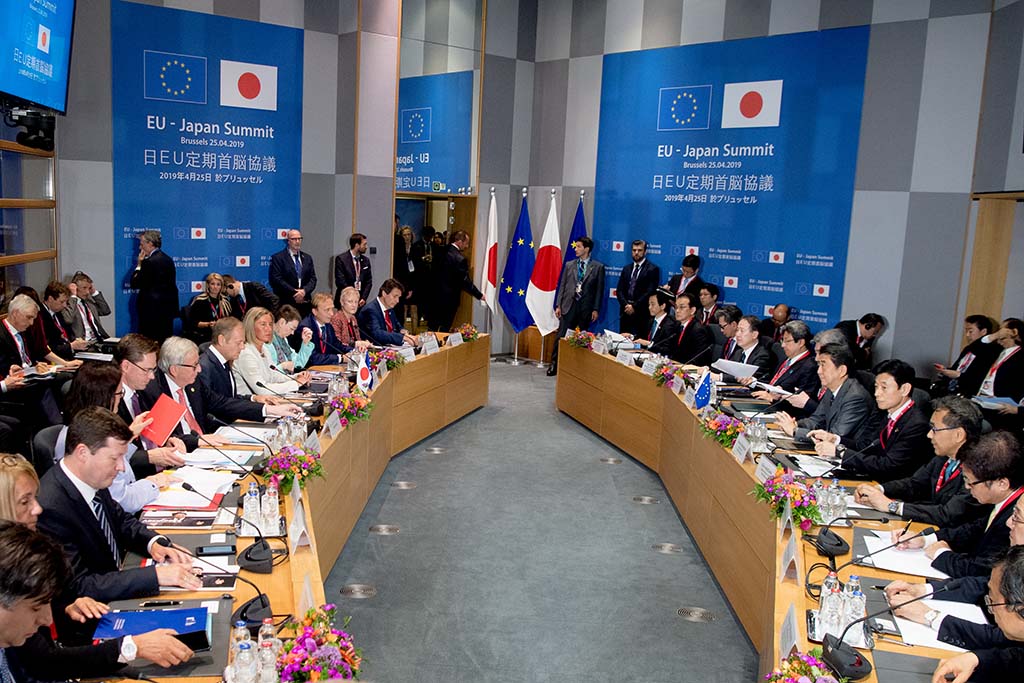With just few weeks for the opening of the G20 summit in Osaka on 28-29 June, the stakes that the world economy faces are higher than ever. The current US-China trade turmoil is precisely what Japan and the EU are trying to avoid.
Since the 2008 financial crisis we have witnessed almost a decade of uninterrupted global economic growth with moderate inflation. However, with a downgraded 2.9% growth projection in 2019 by the World Bank we may be approaching the end of the cycle, whose effects might be aggravated if the biggest economies resort to protectionist measures.
This decade has seen many discussions about ways to achieve sustainable economic growth, fulfil the UN millennium goals and implement environmental commitments, first of the Kyoto Protocol and now of the Paris Agreement. It is in this framework that a new partnership has been established to respond to these challenges and send a clear message in defence of the liberal international economic order. In this light, the EU and Japan are actually walking together in the same direction . They share concerns that have arisen about the global economy since the 1990s : the post-Cold War order, the Financial Big Bang, the emergence of China and the ambivalent dynamics of the emerging markets and developing economies (EMDEs).
“the EU and Japan are actually walking together in the same direction. They share concerns that have arisen about the global economy since the 1990s”
It was precisely a day before the G20 meeting in Hamburg in 2017, where Japan was chosen to host the 2019 summit, when Shinzō Abe, Donald Tusk and Jean-Claude Juncker jointly announced that Japan and the EU had reached a broad consensus over an Economic Partnership Agreement (EPA) and a Strategic Partnership Agreement (SPA) . It should not have come as a surprise given Abe’s intensive efforts to counterbalance the moves of his main foreign political ally, Donald Trump, who has however held completely opposite policy views regarding trade. Abe is adept at signalling his position regarding free trade and the preservation of the liberal economic order is part of his trademark economic policy, the so-called Abenomics. Only a day before Trump’s inauguration, the Japanese Diet ratified the Trans-Pacific Partnership Agreement (TPP), even though it was assumed that it would not come into effect once Trump took office and fulfilled his campaign promise of withdrawing the US from its commitment. Japan has since taken the lead to convert the failed TPP into the new Comprehensive and Progressive Agreement for Trans-Pacific Partnership (CPTPP) that tries to lure in the post-Brexit UK, South Korea and Taiwan, among others, including –paradoxically– the US.
It is interesting to see a sort of circular chain reaction in the various steps taken to ensure that a liberal ruled-based order continues to govern world trade. The new initiative in the Pacific area was in fact given a push by the upcoming creation of the largest free trade area, as the EU-Japan EPA was due to enter into force (1 February 2019). And the latter was precisely propelled by factors including the apparently impending conclusion of the TPP, which pushed the EU to negotiations with Japan after a rather successful EU-Korea Free Trade Agreement (in effect since 2011 and fully implemented from 2015), the dissipation of the TPP that jeopardised Japan’s economic future, the Brexit vote that put at risk Japanese companies’ leverage in Europe and the Australia-Japan Free Trade Agreement, which took more than seven years of negotiations to see the light in 2014 but had a key role in managing the difficult Japanese agricultural, pharmaceutical and auto industry lobbies, decisive sectors also in the EU negotiations.
The key to a successful and unusually fast conclusion to both economic and strategic partnership was, on the one hand, the similarity of the two mature markets with comparable protection structures and, on the other, the transparency of the negotiations in the trade agreement, not so much in the strategic partnership that relied on much more sensitive information.Figure 1. Market sizes of current largest free-trade areas
| EU-Japan EPA [in effect from 1/II/2019] | TPP-11 (CPTPP) [in effect from 30/XII/2018] | |
|---|---|---|
| 640 | Market in million people | 499 |
| 27.8 | World trade share (%) | 14.4 |
| 35.8 | World GDP share (%) | 13.3 |
| EU Real GDP Increase (+0.10~0.76%) + 162,000 jobs Japan Real GDP Increase (+0.26~1%) + 260,000 jobs | Expected gain | US$147 billion |
Source: data from the EU Commission, Japanese Ministry of Foreign Affairs, World Economic Forum and Peterson Institute for International Economics.
Though early to have data, with Japan being the 5th largest partner for the EU in both imports and exports, it is expected that EPA will provide a boost of €13 billion to European exports, which would reach 5% of Japan’s market share, up from the current 3%. The EU would increase its imports from Japan by €23 billion by 2035, the year of full implementation of the agreement, according to the EU DG Trade estimates. The EU will essentially scrap 99% of the tariff lines and liberalise 100% of imports in seven to 10 years while Japan will do the same for 97% of tariff lines and 99% of imports in 15 years. Some products, such as alcoholic beverages, textiles, chemicals, cosmetics or jewellery, have been fully liberalised since day one of the implementation of the agreement but most of the sensitive products, such as wood, leather, footwear and agricultural products in the case of Japan and vehicles and auto parts in the EU’s, remain to be freed from barriers by stages. Even import items not fully liberalised on the Japanese side have been granted concessions in tariff quotas. Some items have never been a subject of the negotiations, including rice, seaweed and whale meat. According to the research presented by Felbermayr e.a., 86% of the gains in mutual trade are owing to the elimination of non-tariff barriers (NTB), and half of that in the services sector alone. Only the remaining 14% result from the elimination of tariffs proper. For example, regarding sanitary and phyto-sanitary (SPS) measures, both sides have simplified approval and clearance procedures. In the EU this specially helps the value-added agri-food sector while in Japan the manufacturing and services sectors benefit. The adoption by Japan of around 200 European Protected Geographical Indications has been a major step forward.
In their final version, both the EPA and SPA deals address other key concerns too. In the first place, they include a clause safeguarding the compliance with the Paris Agreement on Climate, creating a precedent that aspires to set a standard for future trade agreements. Secondly, they attach great importance to data protection. It has been a major step for Japan to accept and model part of its procedures on the already comprehensive General Data Protection Regulation (GDPR), which commits Japanese companies to comply with European standards even when operating in third countries with information originating from European customers/clients/providers. In fact, the matter of safe data flows is considered the Data Movement Agreement or a third major agreement in its own right. Abe has taken the lead on world-wide data governance by putting on the agenda of the G20 summit in Osaka the commitment to work towards a regime built on Data Free Flow with Trust (DFFT) principle aiming at what he calls the Society 5.0 .
Thirdly, these agreements have been presented as a pillar of the Abenomics’ so-called third arrow of structural reform. The effect of their adoption could be called a positive upheaval where the exposure to liberalised trade is used as an opportunity to revamp primary and secondary sectors as well as to modernise the tertiary one by adapting to the new challenges. Akeda noted the difference between the Japanese approach at the negotiating table, more business-oriented and flexible compared with the more people-oriented and normative European style. Japan clearly pursues the improvement of economic efficiency through FTAs and one aspect that took longer in the negotiations were the European prescriptions such as those on adopting more international industrial standards (ISO). Currently, of the 10,773 Japan Industrial Standards (JIS), 6,062 correspond to international standards, with only 38% fully identical to ISO ones. This lack of international standardisation has been one of the NTBs that protected Japanese Small and Medium Enterprises (SME) that cater to a captive domestic market without the need to internationalise. In fact, SME productivity has been long under scrutiny. To force them to open up to the global market and embrace opportunities brought by the digital economy is part of the strategy of the third arrow.
The fourth important point of the agreements is EPA’s 20th chapter, devoted to the role of SMEs in global trade. Up to 88% of EU exporters to Japan are SMEs, which account for approximately 30% of trade volume. SMEs are predominantly responsible for agriculture, textile, apparel and leather products in the goods trade, and for information, communication, real-estate activities, construction, wholesale and retail in the services trade. Energy, auto, computer and electronics manufacturing as well as financial and insurance services rely on bigger corporations. The chapter tries to promote transparency of information, equal opportunities and specialised help to SMEs and their consortiums when, for example, bidding for public procurement, one of the Japanese markets that Europeans have newly gained entrance to. SMEs will see their position improved due to the reduction of NTBs and the decrease of the proportion of fixed costs of accessing the Japanese market.
Some issues have not yet been fully agreed upon, like the arbitration court and procedures in case of foreign direct investment. However, on balance, as already stated by a very comprehensive LSE study on the impact by sector of the EU-Japan EPA, ‘this new trade area would create a “smart, sustainable and inclusive growth”, jobs and welfare, with no negative impact on environmental indicators, and positive effects for the EU social indicators’.
“A challenge for two mature societies such as the sustainability of the welfare system need companion policies to a free trade agreement to ensure its accomplishment”.
This benevolent conclusion might take more to implement than just the free movement of goods and services. Part of the less known SPA leaves an ambiguous set of goals to cover, where the intentions have been signed but the mechanisms are yet to be designed. It has been stablished to promote policies in the areas of gender equality, consumer protection and safety and responsible consumption, but it would have been more encouraging if quantifiable goals and measures on these issues were mentioned. A challenge for two mature societies such as the sustainability of the welfare system need companion policies to a free trade agreement to ensure its accomplishment. There is a commitment to a coordinated emergency response as well as establishing prevention systems in the event of natural disasters, or the cooperation and mutual exchange in higher education and technology that could lead to shared research and outcomes. The common fight against cyberterrorism and the protection of intellectual property are some of the most discussed areas during the round tables. Common efforts in the designing of smart solutions for the future of mobility and urban living, or providing ideas on how to involve the local and regional economies in this new scenario will prove that the agreements that have been signed are just more than a simple partnership but a coalition for a future and stable set of rules.



